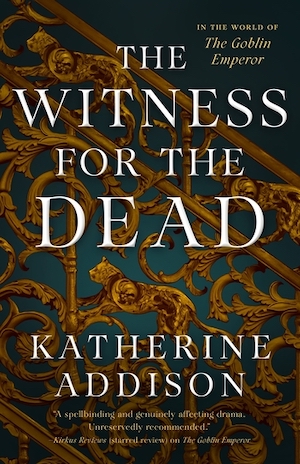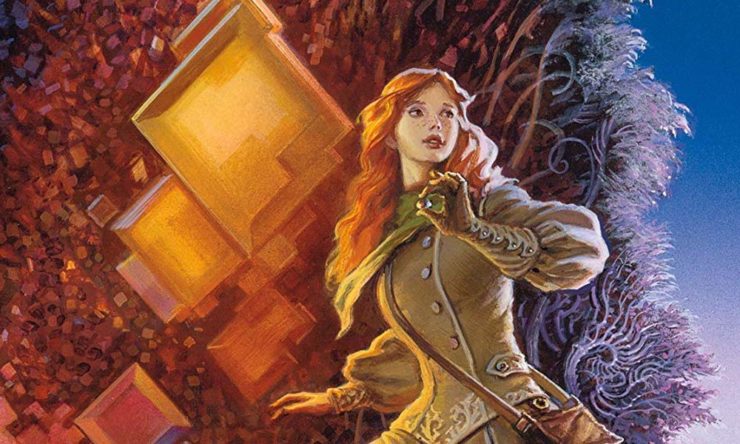There’s a complaint I’ve come across several times in the last year on The Stormlight Archive subreddit: there are, some readers lament, too many Knights Radiant, which are akin to superheroes on the planet Roshar. Radiants can heal themselves, manipulate gravity, change one object into another, see the future, play with pressure, create visual and auditory illusions, among other powers. There are ten Orders of the Radiants and each Order possesses two powers, which are fueled by stormlight—a form of investiture delivered by the highstorms and stored in gems of several varieties.
[Contains spoilers for all books of The Stormlight Archive]
For these readers, it was fun to see Kaladin overcome his inner wretch and become a Radiant in The Way of Kings, followed closely by Shallan in Words of Radiance (though with Shallan things are not as simple, given that she had bonded Testament the Cryptic at a very young age, which was not known to readers until Rhythm of War). Then, as the series progressed, almost all of the main cast (and some sidekicks) bonded spren and became Radiants or Squires: Jasnah, Dalinar, Renarin, Navani, Teft, Bridge Four, Gaz, Vathah…even Wit, our beloved worldhopper. Elhokar and Tien had also initiated their bonds but didn’t finish speaking the First Ideal. As of Rhythm of War, there are hundreds of Windrunners and dozens of Edgedancers, with the other Orders recruiting as well.
Everyone having superpowers, these readers felt, made the concept of the Knight Radiant less impactful. It took away the awe and admiration inspired by heroes who are exceptional and different from the rest of us who look up to them. They also felt that these other characters became Radiants too easily; they didn’t earn Radiance the way Kaladin did by not giving up when his life couldn’t seem to get any worse, didn’t suffer as Shallan did in confronting the truth of having killed her parents and her spren.
As long as it was just these two special people getting singled out, the argument goes, things were great. But everyone around them becoming Radiants as well? What kind of a superhero story is that?
A reassuring and hopeful one, I say.
I’ve never been a lover of superhero narratives, either as a kid or an adult—the violence, yelling, and widespread infrastructure damage that characterize most of these stories in comics and movies was just never my cup of tea. In terms of my reading, The Stormlight Archive novels are the only books I’ve read where the main characters can be called superheroes. Even then, that wasn’t the reason I picked the series up—I initially read them because my book club was doing a read-along and I wanted to join. Over the year that’s passed since discovering the series, I’ve talked a lot about it with friends as well as fellow fans on Reddit, read fan-fiction, shared memes, envied the skills of fan artists, and written a meta essay of my own about the scholarship in the books. I love the series for its representation of mental illnesses and for how diverse the characters—especially the women—are in terms of personality and strengths. Shallan, Jasnah, Navani, Lift, Rushu, and Rysn are some of the best female characters I’ve ever read.
It was only when I came across these online discussions based around some readers’ disappointment at the fact that (almost) all the main characters were becoming superheroes that I realized that yes, this series is different from other kinds of stories with knights and superpowers—that there aren’t just one or two very special characters with very special powers—and that yes, I love it. To explain why, we’ll have to go back a little in time.
I took a gap year before starting college in 2019. I was at home most of the time, with no social circle, wondering what to do with my life. I spent that year experiencing a mix of climate anxiety and death anxiety and going through an existential crisis all at once. I could see so many problems in the world—sexism, racism, casteism, homophobia, climate change, lack of mental health awareness—and it was too much to take in. I read a lot about possible solutions to these problems. And then I started believing that I had to do something to fix those things. That I shouldn’t just be a writer but also a journalist and a lawyer and a social worker and a politician, because those positions would let me change things. That I had to do it all, or my life was worthless. The world was ending, millions of people were at risk of losing their homes and lives due to rising sea levels, fires were consuming entire forests, and living till my 50th birthday was looking like an impossibility. Someone had to do something. I had to do something.
Buy the Book


The Witness for the Dead
The worries and anxiety dragged me down until all I could do was just sit and think over and over about how hopeless things were. I cried. I felt helpless and frustrated and angry because the people who held the most powerful offices in the world and led the world’s largest democracies weren’t doing anything.
What finally pulled me out of that space and still keeps me going is this truth was this realization: saving the world is a lie.
In stories, the superheroes perform all the world-changing heroics. They are usually mysterious and almost always set apart in some way from the other people in their lives—by a secret identity, perhaps, or simply because they are so different, so powerful. Not in The Stormlight Archive though… In these books, superpowers aren’t limited to a chosen one. Or even a few chosen ones. What I love about this magic system is that your powers don’t come from an external source—no special creature/weapon/serum/prophecy/heredity, etc. People who care about others and hold themselves and their behavior to certain moral standards become Radiants. You don’t need noble blood, or (any) education, or special favors, or any privilege whatsoever. You just need to give a shit about other people, and give enough of it. You have to be the kind of person who keeps their promises. And that is anything but easy, given the kind of problems life throws at people.
Anyone in the world of Roshar (and even those outside it, like Wit/Hoid) can become a hero. Granted, the Nahel bond which gives the Knights Radiant their powers is initiated by a spren who follows a person around and encourages them to speak the Immortal Words. But spren don’t discriminate in their choices the way the real world does in choosing the people it grants power to (or allows to steal power). Tien was an ordinary (yet precocious) village boy when a Cryptic started following him. Ym was an urchin-turned-shoemaker in the process of bonding a Mistspren. Gaz, Vathah, and Red were deserters before Shallan took them in. Lift was (and still is) a little thief; the Stump just an old woman feeding orphans. Godeke the Edgedancer is an ardent, who are usually owned by royals and lighteyes. Beryl the Lightweaver was a sex worker at the warcamps. I’m guessing that the majority of budding Radiants that the Herald Nale killed over thousands of years were ordinary people too.
Despite their name, not all Knights go out into battle to fight—not during the current timeline, or in the past, as Jasnah pointed out to Shallan:
The archetype of Radiants on the battlefield is an exaggeration. From what I’ve read—though records are, unfortunately, untrustworthy—for every Radiant dedicated to battle, there were another three who spent their time on diplomacy, scholarship, or other ways to aid society. (Words of Radiance, p. 81)
And I like that because it feels more real: A lot of us want to help but can’t because we don’t know where to begin or are struggling with our own problems. The thing with Radiants is that they run into these barriers too, but because they’re willing to change and grow, they acquire this power and are able to help others.
Over the last year, having followed the protests around the world, and closer home in India, I have learned a lot about how people can take little actions—signing petitions, sharing information, initiating conversations, making little donations, taking courses to learn more, addressing their own biases—to help a cause. You do not have to sit in the Oval Office. You don’t need billions of dollars. You don’t need to be an expert, a scientist, a doctor, a lawyer. You can still create change even if you aren’t any of those things.
Because the real world has never been saved by a few superheroes. It has always saved itself on its own, each person doing their own little bit. In the real world, although many people feel—and sometimes are—helpless because they’re not the “right” gender or race or caste or class, there are many, many more people who have made their own little impacts on the lives of others, be it buying groceries for elderly neighbors during the lockdown, running a lemonade stand to raise funds for cancer treatment, offering free therapy, teaching kids in slums, or distributing food to protesters. Our world is humanity’s collective effort, one big project that we always keep working on.
The problems all of us are fighting are too big to change individually—they are too massive in scope, with too many variables. But collectively we have changed some things for the better, and we’ve done it by being whoever we are and doing what we can, while also learning and taking tiny steps forward, just like the Radiants do with their skills and their Oaths. And although we all have heroes like Kaladin—people we can look up to and admire for being extraordinary—we know that the world isn’t dependent on a select few and that all of us can grow and change things and be a hero in our own ways.
And that is anything but disappointing.
Ratika Deshpande’s (she/her) work has appeared in Flash Fiction Magazine and Every Day Fiction. She has also written for Submittable’s blog, Discover. She’s good at summarizing long conversations, better at finishing work before the deadline, and best at making bad jokes. She lives in New Delhi, India, and is currently pursuing a Bachelor’s in Applied Psychology.










